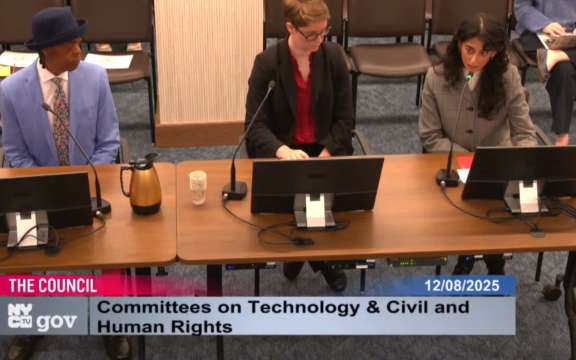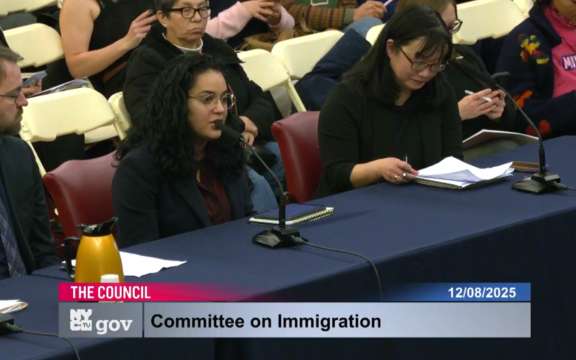Devastating New Report 'The Walls Are Closing In On Me' Documents Surge in Suicide & Self Harm in Solitary Confinement in New York State Prisons
FOR IMMEDIATE RELEASE...
Contact: Jared Chausow, jchausow@gmail.com
**Watch a recording of today's press conference using this link (password: 0t&L@r8?)**
DEVASTATING NEW REPORT ‘THE WALLS ARE CLOSING IN ON ME’ DOCUMENTS SURGE IN SUICIDE & SELF HARM IN SOLITARY CONFINEMENT IN NEW YORK STATE PRISONS
Using Exclusively Obtained State Data, the Report Finds Record High Number of Suicides in NY Prisons in 2019, with a Suicide Rate Nearly Twice the National Average and More than a Third of All Suicides in Solitary Confinement
The Report Also Finds Suicide Attempts in NY Prisons Nearly Every Other Day, with a Rate of Suicide Attempts that is 12x Higher in Solitary Confinement
(New York, NY) -- Today, New Yorkers who have lost loved ones to suicide in solitary confinement joined NYS Assembly Health Committee Chair Richard Gottfried, renowned Yale School of Medicine psychiatrist Dr. Bandy Lee, former Rikers mental health chief Mary Buser, and other advocates with the #HALTsolitary Campaign to announce the release of THE WALLS ARE CLOSING IN ON ME (link), a devastating new report finding a surge in suicide and self-harm in New York State prisons, with solitary confinement as a primary driver. The report comes at a pivotal moment, as the spread of potentially deadly coronavirus infections, the systemwide elimination of programming and visits, and the inappropriate and dangerous use of solitary confinement instead of proper quarantine, medical isolation, and care and treatment put extraordinary pressure on incarcerated people. At the same time, New Yorkers abiding by orders to mostly remain at home are getting just a small glimpse of the exponentially more devastating horrors of solitary confinement. The #HALTsolitary Campaign, an effort led by survivors of solitary confinement and their loved ones, is organizing to pass the Humane Alternatives to Long-Term (HALT) Solitary Confinement Act, which would end the torture of prolonged solitary confinement and replace it with more humane and effective alternatives.
Key Facts:
- In 2019, 18 people died by suicide in New York state prisons. This was the highest rate of suicide in New York prisons since 2000, and was 88% higher than the average rate of suicide in prisons across the country. From January through April 2020, five people already have died by suicide in New York prisons.
- At least one third of the suicides in 2019 took place in solitary confinement. The rate of suicides in solitary in NY prisons was ten times the overall national prison suicide rate, and is likely even higher because of a lack of data on suicides in keeplock and other forms of solitary.
- The rate of suicides from 2015 to 2019 is over five times higher in solitary confinement than in the rest of the prison system, and is likely much higher because of a lack of data on suicides in keeplock and other forms of solitary.
- Half of the people who died by suicide in solitary were young people in their twenties and 65% were People of Color, rates dramatically higher than the rates of suicide by these groups in the rest of the prison population, indicating how much of a direct role solitary played in many people’s deaths.
- Suicide attempts in NY prisons occur nearly every other day. From January 2015 through April 2019, there were 688 suicide attempts in the state prisons, representing an average of one suicide attempt every 2.27 days.
- From January 2015 through April 2019, 43% of suicide attempts occurred in Special Housing Units (just one form of solitary confinement), at a rate 12 times the rest of the prison system. As with suicides, the rate likely much higher if all forms of solitary confinement were included. The rate of suicides in purported alternatives to solitary for people with the most serious mental health needs (but too often amount to solitary by another name) were 26 times the rate in the rest of the prison system.
Akeem Browder, Social Justice Advocate and Founder of the Kalief Browder Foundation, said: “I personally know the effects of solitary confinement from my own period of incarceration, where I spent eight months in solitary. I also know the devastating impacts of losing a family member to solitary. Everyone knows what happened to my brother. How torturous solitary confinement is and how it took Kalief from us. Yet New York continues to throw people away in solitary confinement? Even during a pandemic when medical professionals say how harmful solitary is and how it actually spreads the virus? It is truly appalling that New York State has still not enacted the HALT Solitary Confinement Act. Of course people are still dying by suicide in solitary as this report shows. As more and more family members lose their loved ones like I did, I just can not comprehend why they haven't passed HALT.”
Darlene McDay, whose son Dante Taylor, died by suicide in solitary in NY, stated: “What happened to my son should never happen to another person. The state knew Dante was at high risk of suicide. Yet they locked him in solitary confinement in keeplock for months. Then officers beat him to the point of being unrecognizable and then locked him back in solitary confinement again. He was only 22 years old. As a mother, the heartache and grief will never go away. I am haunted every day with thoughts of the unimaginable pain and hopelessness that my son suffered from being isolated from any support system. New York must stop using solitary confinement. It is torture and it must end.”
New York State Assembly Health Committee Chair Richard Gottfried said: “When the Bush administration was being accused, rightly so, of running a campaign of torture in Guantanamo and in prisons around the world where we were holding alleged terrorist suspects, when there were really gruesome reports of torture of those prisoners, part of the Bush administration’s claim was it wasn’t really torture because people aren’t really dying from it so it can’t really be torture. Well, what this report shows is that people are dying from [solitary] and if people dying from it is part of the definition of torture, this is even more evidence that solitary confinement is not a management tool, it’s not punishment, it is torture...the Governor runs the correctional system...In the legislature we have been fighting for several years for a bill to end solitary confinement. I believe it is more important than ever, and this report makes that clear, for both houses to pass this bill and get it on the Governor’s desk...And again, let’s not forget the Governor could do this with the stroke of a pen this afternoon if he had a mind to.”
Renowned Yale University School of Medicine Psychiatrist and corrections expert Dr. Bandy Lee said: “Prolonged solitary confinement is one of the worst forms of torture for humans, who are social animals. This is corroborated by research, clinical observation, and neuroscience. The high suicide rates, in certain settings as much as 12 times that of the general prison population--already a demographic at high risk for self-harm--is a grave indictment of our inhumane practices. This extreme punishment shows little understanding of mental health, does great harm to its victims, and only increases dangerous and self-destructive behavior when people get out, if they do at all. The HALT Solitary Confinement Act is an important and urgent piece of legislation that can put an end to a practice that has been observed as barbaric for almost 200 years.”
“Every day, our team was called to the Solitary Confinement Unit, where incidents of self-mutilation far outpaced the rest of the jail. We prescribed medication, talked to the person inside the cell, and generally did everything we could to mitigate the grueling impact of isolation. But when the length of time inside these cells stretched into weeks and months, our very best efforts failed. Even the most potent medication was no match for the ongoing horror of solitary confinement. Suicide attempts were a daily occurrence and it was our job to see that no one died. If we felt death was imminent, we had the authority to remove the person from the cell – but only until they were sufficiently recovered to go back in. I thought that solitary confinement had all the earmarks of torture,” said Mary Buser, former assistant chief of mental health in the Rikers Island Central Punitive Segregation Unit.
Background:
Experts agree that the sensory deprivation, lack of normal interaction, and extreme idleness of solitary can lead to severe psychological, physical, and even neurological damage. A recent study found that people who spend time in solitary are much more likely to die upon release from prison, including because of increased rates of suicide. During this pandemic, these physical and mental health harms of solitary weaken people’s immune systems and are greatly exacerbated, making people in solitary especially vulnerable to COVID-19. Meanwhile, rather than following the advice of health experts to release thousands of people from prison and ensure the health and safety of those left behind, New York is doubling down on the use of solitary, including continuing to send people to solitary for absurd reasons and with facility-wide lockdowns and individual placements in solitary for people who report symptoms. (Health experts have also called for correctional systems to stop the use of solitary and avoid lockdowns as a response to the virus.)
While human rights standards adopted by the United Nations state that solitary beyond 15 days is torture, New York State regularly holds people in solitary for months, years, and decades.
Even prior to COVID-19, use of solitary confinement had actually increased since Governor Cuomo claimed to have implemented reforms in 2015, with more than 38,000 solitary sentences in 2018 and 81% of people in solitary being Black and/or Latinx. Advocates are calling for lawmakers to enact the H.A.L.T. Solitary Confinement Act – which has majority support in both the Senate and Assembly – to end this racist torture and replace it with more humane and effective alternatives.
In ordinary times, solitary itself is a public health crisis that causes immense suffering and far too often leads to heart disease, psychosis, self-mutilation, and death. Deemed torture under international standards, people in solitary are locked in a cell without meaningful human contact or programming. New Cornell research found that even a few days in solitary confinement – and even only one or two days of solitary – led to significantly heightened risk of death by accident, suicide, violence, and other causes. One study published this summer in the Journal of General Internal Medicine found that solitary confinement is associated with a 31% increase in hypertension. Approximately one-in-three people in solitary who participated in the study were more likely to experience heart attacks, strokes, and – unsurprisingly – higher degrees of loneliness, which also contributes to heart disease. This study was followed by another one this fall which found solitary confinement is associated with increased rates of death after release, particularly by suicide as well as overdose.
While Governor Cuomo has put forward proposed regulations on solitary confinement, an analysis shows these regulations will continue to allow people to be held in solitary for months and years, including for minor infractions.
Thanks to efforts led by survivors of solitary and their family members, there are more than enough votes in the Legislature to pass HALT. 34 New York State Senators from Long Island to Upstate New York are officially co-sponsoring the HALT Solitary Confinement Act – a clear majority – and additional Senators have committed to vote for the bill as well. 79 New York State Assembly Members also officially co-sponsor HALT – another clear majority – and the bill passed in that house in 2018. An analysis shows HALT will save money.
Learn more at www.nycaic.org.
###


